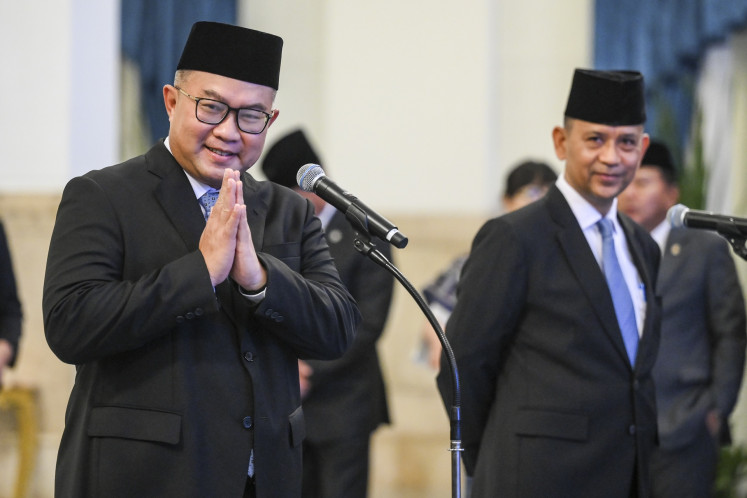Popular Reads
Top Results
Can't find what you're looking for?
View all search resultsPopular Reads
Top Results
Can't find what you're looking for?
View all search resultsBournonville ballet takes root in Indonesia
Strong yet subtle: Ballet students from Cicilia Ballet School and Ballet Sumber Cipta perform Bournonville ballet at the Teater Kecil in Jakarta back in 2017
Change text size
Gift Premium Articles
to Anyone
S
trong yet subtle: Ballet students from Cicilia Ballet School and Ballet Sumber Cipta perform Bournonville ballet at the Teater Kecil in Jakarta back in 2017. (Photo courtesy of Fajar Kristianto)
For ballerina Wenny Halim, the seeds of her dream to popularize the Bournonville ballet tradition — a Danish national treasure — in Indonesia, have just started to sprout.
Standing in a ballet studio in Pondok Pinang, Kebayoran Lama, South Jakarta, the 38-year old Wenny, who is also the cofounder of the Mudamove dance troupe, ruthlessly scans a crowd of ballet dancers.
The dancers were part of the August Bournonville Summer Academy in Jakarta, a one-week master class named after the 19th century Danish choreographer and ballet master.
Wenny was looking for dancers with a strong yet supple plié. This means having the potential to achieve the illusory lightness of the Bournonville style, where the dancers finish the jumps with a plié, so as to disguise an abrupt landing.
Wenny also collaborated with Frank Andersen and Eva Kloborg, the two most important interpreters of the Bournonville style in modern times, for the master class.
“It’s beautiful to watch Frank and Eva bonding with the girls. In the Bournonville method, we do three combinations continuously — en face, croisé, effacé — and then repeat in reverse. You have to think quickly,” explained Wenny.
“Once you memorize these combinations, you can read and execute any ballet dance formula. It’s a very intelligent method.”
On June 30, audiences will see the trained ballerinas perform La Sylphide at the Teater Kecil in Jakarta. La Sylphide is a celebrated piece from the Bournonville repertoire that has become a cornerstone of romantic ballet.
Minor details: Frank Andersen and Eva Kloborg coach Indonesian ballet students in Jakarta. (Photo courtesy of Wenny Halim)Choreographed by the then 31-year-old Bournonville in 1836 to revive the repertoire of the Royal Danish Ballet, La Sylphide tells a tragic story of earthly love destroying a supernatural spirit. A young Scottish farmer chases the love of a spirit over a human marriage, eventually capturing her with the help of a witch, and in doing so, killing her.
Wenny first heard the term “Bournonville” in 2011, when she attended a teacher training program at the American Ballet Theatre in New York, United States.
“We were training in blended Italian, French and Russian styles, and the teacher would tell us that we were not touching Bournonville,” she said.
The teacher told Wenny that Bournonville was completely different and this piqued her curiosity. According to Wenny, the teacher said Bournonville dancers always jumped in syncopation.
“In ballet language, syncopation means more steps than music beats, so I was intrigued,” Wenny said.
In 2012, Wenny randomly bought a book titled Letters on Dance and Choreography, written by Bournonville in the 1860s.
Unexpectedly, she immediately related to Bournonville’s profound thoughts on how performance art institutions treated the art of theatrical dance and its practitioners in the 1860s.
“I fell in love with Bournonville’s thoughts before his dance style,” said Wenny.
“So, I started watching Bournonville videos on YouTube nonstop and was fascinated.”
Practice makes perfect: Young Indonesian ballet students participate in a Bournonville class in Jakarta. (Photo courtesy of Wenny Halim)Bournonville’s critique of the deterioration of ballet into gymnastics and the inadequate compensation of ballet dancers in the 1860s spoke strongly and directly to Wenny.
In 2014 and 2015, following the calling of her muse, Wenny twice stretched her finances to attend Bournonville master classes in Copenhagen and Tokyo.
“I want my girls to dream to become the Sylphide, Giselle, Juliet and the Swan, not just to finish the syllabus, get some prize, and then quit ballet before they dance in a real show. All the pieces in the Bournonville repertoire are story ballets and you can’t simply take out the scenes to go to a competition. And I needed to bring that to Jakarta,” Wenny said.
The Bournonville style takes much effort to appear effortless, and thus it is not genetically coded for competition. It avoids using spectacular bravura, instead letting the steps carry a continual storyline forward.
Many minor connecting steps logically prepare for the climax — the big leap and turn. The Bournonville style enables dancers to spend more time in the air than on the ground, thus expressing the spirit of Romanticism; the fairy tale versus reality, the mythical versus the mundane, lightness versus gravity.
“There is so much work to do before we can even start talking about a ballet company of Jakarta,” said Wenny.
“Let’s bring back the art and poetry in ballet first.”












